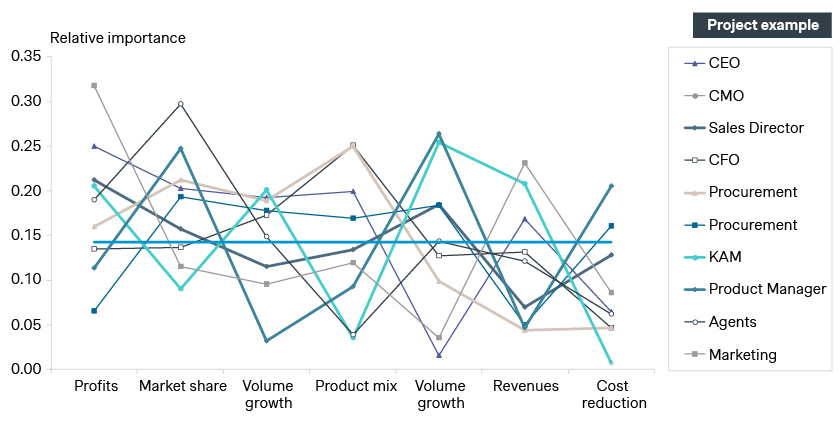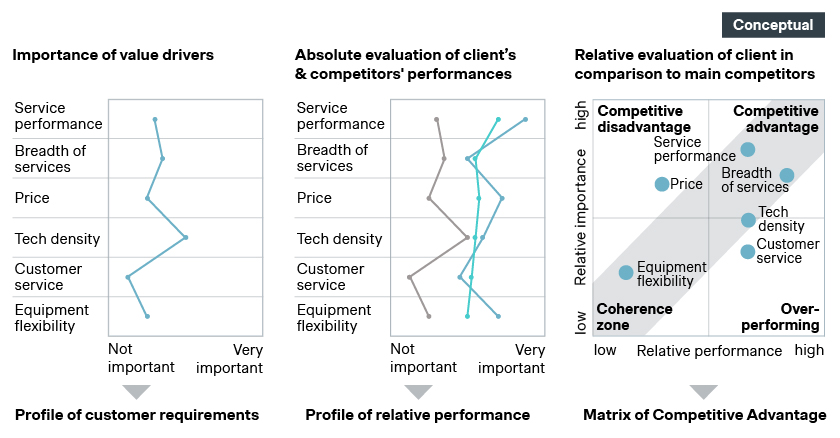At Simon-Kucher, we define price leadership as more than just a CEO managing numbers. It’s about strategically aligning pricing with customer value and business objectives to create sustainable growth in competitive markets.
Price leadership isn’t about racing to the lowest price or reacting impulsively to competitive pressures. It’s about crafting value-driven pricing strategies that foster long-term success. True price leadership is a mindset that elevates pricing to a strategic priority, demanding senior leadership’s ownership and accountability. This involves making data-driven decisions based on customer willingness to pay and perceived value.
But what does it take to master price leadership? Here’s a CEO’s guide to navigating this critical but often misunderstood element of business strategy.
1. Define your goals—and what you won’t do
Effective price leadership starts with clarity. As a CEO, your objectives must be sharply defined. Are you prioritizing profit, revenue, volume, customer satisfaction, or market share? The trade-offs are unavoidable but essential to get right.
Equally critical is knowing your boundaries. What will you not pursue? For instance, chasing market share by indiscriminately slashing prices may feel tempting but often leads to unsustainable outcomes. Instead, focus on delivering value while ensuring ethical, independent pricing decisions that avoid market manipulation.
Lean on data, not anecdotes. Avoid reactionary pricing moves and align your leadership team around shared objectives. Conflicting priorities can create chaos, so establish clear forums for open, transparent discussions among your leadership team, some of whom will have different priorities. Remember, a CEO who waffles on pricing sends confusion through the organization. Be decisive yet adaptable when the data demands it.
Here's an example of how confusing and misaligned goals can be within an organization:

2. Understand—and charge for—the value you deliver
Do you truly understand the value your products provide? Many CEOs fall into the trap of undervaluing legacy products while overhyping innovations. It’s easy to chase the allure of the “next big thing” only to find its solution in search of a problem.
Conduct impartial, market-based research to avoid this. Validate your assumptions with real-world data. For legacy products, consider hidden factors like peace of mind, exit barriers, and longstanding customer relationships.
Resist one-size-fits-all pricing approaches. Differentiate strategies for legacy versus new offerings based on their unique value propositions. Challenge your teams to substantiate their value claims with evidence. Without this discipline, you risk leaving money on the table—or worse, eroding customer trust.
Ask yourself: What drives your customers’ willingness to pay?

3. Craft a unified, confident message for your team
Consistency in messaging isn’t just important—it’s non-negotiable. Your team must believe in and take pride in your pricing decisions. Mixed signals can undermine confidence and focus.
Never apologize for pricing decisions rooted in your product’s value. Be bold in asserting the worth of what you offer, and focus on communicating the value proposition and strategic rationale behind your pricing.
4. Treat pricing as an ongoing effort
Pricing is not a one-time task during budget season. Market conditions shift, customer needs evolve, and competitors adapt—your pricing strategy must keep pace.
Key moments for review include new product launches, significant market changes, or external shocks like inflation. However, beware of overreacting. Too many price adjustments can harm your brand’s price integrity and create customer uncertainty.
Strike a balance: Be proactive but not reactive. Assign clear ownership for pricing decisions while staying involved as a CEO. Pricing is a strategic lever, not a tactical afterthought. Engage with it continuously to ensure alignment with your broader business goals.
5. Establish accountability and reward excellence
In many organizations, everyone touches pricing, but no one owns it. That’s a problem. Designate a dedicated pricing leader to oversee strategy and execution. This doesn’t require a massive team—just clear accountability.
Create performance metrics that reflect pricing excellence. For instance, sales leaderboards tied to profitability can drive the right behaviors. And don’t forget to monitor process adherence. It’s not enough to set a strategy; you need visibility into how well it’s executed.
Encourage open dialogue about pricing processes with the team and add mechanisms to track compliance where necessary. Accountability builds trust and ensures your strategy is implemented effectively.
The path to price leadership: A strategic commitment
Mastering the skills of price leadership is no small task. It requires vision, discipline, and a relentless focus on delivering value.
CEOs who define clear goals, understand product value, maintain consistency, engage continuously, and establish accountability will be better positioned to succeed in today’s competitive market.
At Simon-Kucher, we’ve spent decades helping businesses across industries—from industrial goods to oil and gas, construction, and more—navigate the complexities of pricing strategy.
Let’s discuss how we can support your journey to sustainable, profitable growth.
Explore all the insights from our B2B Masterclass
Unlock practical strategies in B2B pricing, sales and marketing



